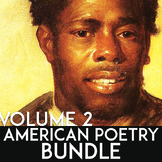Native American Literature | Sherman Alexie | Indigenous Poetry | Stereotypes
- PDF
- Google Apps™
- Internet Activities

Also included in
- Want to immerse your students in the diversity of this country by studying engaging poetry together? Your students will learn so much when they explore the essential questions of American Literature with these ready-to-go lessons.A collection of questions on 24 poems, from the mid 20th century to tPrice $19.97Original Price $45.60Save $25.63
Description
Why are stereotypes dangerous? What is our role in breaking down stereotypes?
Students might know some of the stereotypes surrounding Indigenous people, but they likely don’t fully understand where they come from, why they are harmful, or why positive stereotypes can be equally painful as negative ones. This 90-minute lesson will get them examining some of those assumptions when they explore videos featuring teens talking about stereotypes, a powerful slam poem performance, an accessible and interesting opinion piece, and a funny and satirical poem by Sherman Alexie "How to Write the Great American Indian Novel."
While this lesson is a great introduction to a unit on Native American Literature or a great addition to a unit on stereotypes in general, you’ll need to make sure that students come to understand how and when those stereotypes are not true by exploring multiple voices and perspectives beyond what is included in these lessons.
*All proceeds from this resource will be donated to the Lakota People's Law Project Action Center*
When you teach your classes about stereotypes of Native American people with this unit you will:
- Start your unit with discussion questions and freewrite prompts that will help students to focus, get ready to work, and begin to explore the essential questions of the lesson.
- Strengthen your students’ close reading skills by taking them through a close reading of a poem with the no-prep questions and handouts.
- Easily review the questions using the extensive answer keys which quote the important passages, so there is no guessing on your part as to which parts of the text are most important.
- Incorporate important social justice issues into your lesson plans without sacrificing rigor or student interest.
- Empower different learning styles with group work, dynamic discussion questions, quiet reflection, engaging videos, and contemporary poetry.
- Add rigor to your lesson plans when your students analyze irony, sarcasm, imagery, diction, theme, and point of view in poetry with the structured questions and activities.
- Empower your classes to break down stereotypes and build their empathy for people whose lives are not like their own.
Pairings: This mini unit would pair nicely with a unit on The Absolutely True Diary of a Part-Time Indian, Ceremony, Love Medicine or any unit or text that deals with stereotypes, Native American culture, or Native American Literature.
There are no lectures or power points here—students will do the work themselves, with guidance from you. Rather than telling them what the texts mean, you will be empowering them with the confidence and skills to tackle challenging texts on their own.






